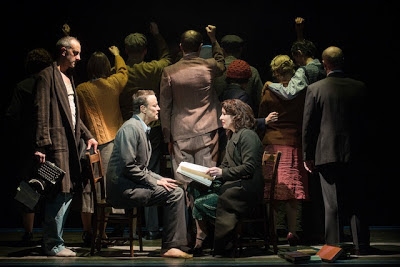It was such a treat to see Simon McBurney/Complicité’s
production of Bulgakov’s masterpiece The
Master and Margarita in Paris last week. The trek out to Bobigny and the
not exactly congenial experience of theatre MC93 was quickly forgotten by what
was, I thought, a riveting and masterful production.
I was mesmerized for three hours by the vivacity of the
production, and especially in its capturing of the complexity of Bulgakov’s narrative.
The weaving together of literary
references, German philosophy, the asceticism and oppression of Stalinist 1930s
Moscow, Soviet and Russian history, Goethe’s Faust and particularly when Margarita makes a pact with the devil
who has come to visit Moscow. And McBurney does not stop there, the centrality
of the variety theatre where the devil stages his show revels in the evil and
excess that befits Satan, while Biblical Jerusalem is pervaded by the solemnity
that befits Pontius Pilate’s trial of Jesus. In a post-World War II world, it
would be difficult not to also note the frequent references to the Holocaust in
McBurney’s production. And with it,
necessarily, comes to mind the contemporary conflict of Israel and Palestine. While the Jewish
pogroms were in full force not long before Bulgakov wrote his book, it's the contemporary resonances that are often most striking. In other instances, McBurney's production makes the connection between eras for us: the narrative thread about Julius
Cesar and his arrest of criminals ricochets through Soviet Russia’s twentieth
century of dictatorships and oppressive violent regimes. This is a work of
immense reach.
As theatre McBurney and Complicité bring a masterful use of
light and sound to the text. The set, the spaces it defined, the changing
dimensions of these spaces, the changing perspectives from which the audience
looks at the worlds created on stage — at times for the briefest of periods — were
all entirely articulated by light and sound. My friend Anne thought that it
bore certain resemblances to the Expressionist cinema's use of light.
It’s true that Bulgakov’s Master and
Margarita engages the confusion between the internal world of the mind and
the external historical world, but I am not convinced that the dramatic use of
light and sound was expressionist. Rather, if it is to be compared to any of
the interwar German art forms, it has to be Erwin Piscator’s political theatre
of the 1920s. Piscator begins the conversation that Complicité takes to overwhelming
ends with the use of film and video images to extend the narrative space and
thematic concerns. For Piscator, the use of film images politicized the individual’s
thoughts and actions, carrying them into the public sphere beyond the literal
and metaphysical prison walls. Moving images created new spaces and places both
real and imaginary in the 1920s. McBurney uses lighting – which includes the video images that saturate the backdrop to open up new spaces, new
perspectives, new dreams — as a way of moving between scenes as well as to
confound the narrative threads. So, for example, in The Master and Margarita, the video images enable what can only be
described as a cinematic edit between the poet’s imagination and the asceticism
of everyday bureaucratic life in Stalinist Russia in a split second.
The reviewer in The
Guardian bemoaned the coldness of the production, a coldness he identified
as deriving from the video images and projection. While I didn't experience this coldness, if the use of the moving images and sounds are seen in the
tradition of the great political theatres of Europe in the 1920s, I wonder if
it’s a coldness that serves the purpose of provocation? Is it a coldness of the order that would become
known as Brechtian distanciation?
Another element of McBurney’s production that I enjoyed was
its focus on Moscow, indeed the visual and textual use of Moscow to enable the unpredictable
geography of the mind. Moscow is, at the same time, very real: its spatial
organization and the fact that, as it is pointed out over and over again in the play, it
was the first city with electricity, are also the stage for a wonderful
modernist drama. Thus, I would argue that this production has a much stronger
grounding in political reality than the German Expressionist films of the
1920s. The very compelling narrative about the poet or writer, who is really a
historian, incarcerated for a novel he wrote about Pontius Pilate, in an
atheist, communist world opens up to the real politics of centuries, as they pervade the streets and fill the air of a very real city.
Lastly, it has to be acknowledged that the piece is given
its brains by Bulgakov, its complex narrative, its layer upon layer of
politics, literature, oppression, dictatorship, history, and imagination. But
what McBurney gives the play is an intense visual life that does what all good
staged theatre should: it compliments and complements Bulgakov’s literary
expertise.





No comments:
Post a Comment